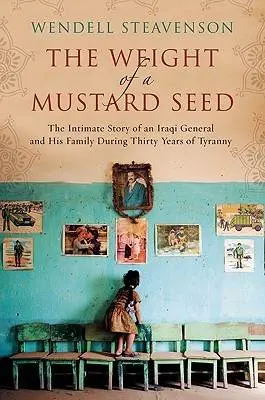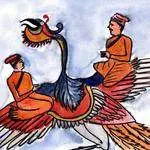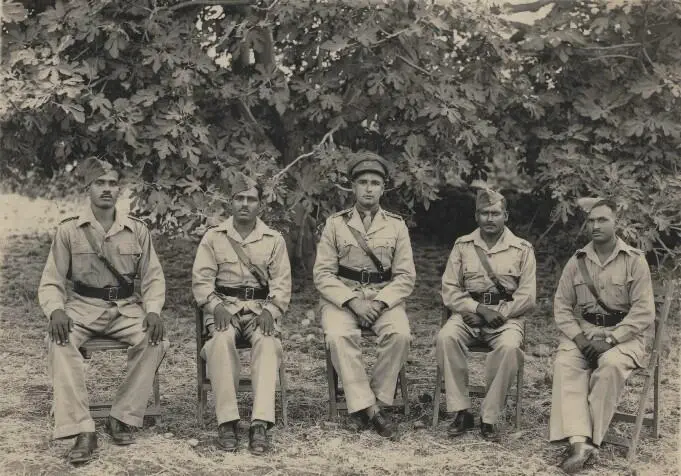
Left to Right: Annamalai, Ponnuswamy, Lt Sukias, Govind Swamy
and Lakshmi Kanthan
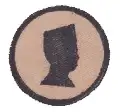
QVO Madras Sappers and Miners’ shoulder patch.
This is the story of four Indians who served in the Queen Victoria’s Own Madras Sappers and Miners during the Second World War. These young men in their twenties were my father Lakshmi Kanthan, Govind Swamy, Annadurai, and Ponnu Swamy. They were Viceroy’s Commissioned Officers (VCO). Interestingly they were incredibly young, born in the 1920s, to be commissioned as such. Their command over the language, education, expertise, and a war may have necessitated such direct recruitment to the VCO cadre. The story is pieced together with information from various sources, the record of service of and as anecdotally related by Lakshmi Kanthan, (actually Devarkonda Chalapathi Lakshmi Kanthan proved to be a challenge to the British officers, who nick-named him, Douglas, later Dugggy)!!
They belonged to 12 Field Company of 4 Engineer Group Royal Indian Engineers and were pressed into service in the North West Frontier Province (NWFP), which is now the Pakhtunkhwa region of Pakistan. The Sappers of 12 Field Company were mostly involved in emplacement works. The interaction with local labour introduced some Pashtu to these young men from the Southern parts of India. As there was relative peace in the region the British were able to free troops towards the war. By July 1941, the company was tasked to go to the Middle East.
Karachi to Basra
The journey from Karachi to Basra was by a ship. Ships moved in convoys comprising troop ships many of which were civilian passenger liners impressed into the war service and warships. It appears that 12 Field Company traveled on a warship. There was no place in the lower decks and Lakshmi Kanthan recalls strapping himself to the upper deck, especially at night. There was also a ban on smoking at night to avoid detection by enemy aircraft. The journey took about 6 days and they were inducted into the PAI Forces at Basra, in Iraq.
Persia and Iraq Command

Persia and Iraq Command.
The British Middle East Command concluded fighting a rebellion in Northern Iraq by June 1941 and reverted the command of the region to GHQ India. These Sappers from NWFP were pressed into service in Iraq under the Persia and Iraq Command (also called PAI Forces).
The company’s main tasks were in water supply, erection of sheds, training of local labour to build Romney huts (prefabricated steel huts) for Ordnance and Base Engineer workshops, and laying PPE lines for fuel and railways.
Their service in the region lasted a year and five months. December 1942, they were on the move again, traveling by troopship from Basra in Iraq to Port Said in North Eastern Egypt.
The North African Campaign

January 1943, they landed at Port Said and went straight into the North African Campaign as part of the 4th India Division with the 8th Army. By then, the tide of war had changed with the US victories in Morocco and Algeria. The Allies started making gains that led to the defeat of the Axis forces by early May 1943. The Sappers of 12 Field Company had arrived at a crucial time when Germany still had a sea transportation capacity to pump in more troops while the British were desperately seeking more from India.
In Egypt, they were employed in the construction of a huge rest camp for the 8th Army, roads, wet and dry bridges, laying of mines, and clearing. Lakshmi Kanthan ran a Bailey Bridge School to train two battalions of Engineers for about three months. They were in Egypt for five to six months before moving on to the next campaign of the 8th Army: The Italian Campaign.
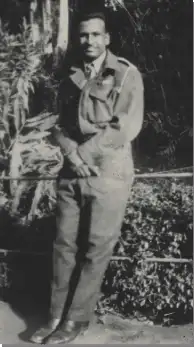
Lakshmi Kanthan at Cairo Zoo
This end of operations did give them some time to be the ‘tourist’ soldier. They visited the Cairo Zoo. It was either work or opportunity that took Lakshmi Kanthan to visit Transjordan, Palestine, Aden, Sudan, Tunis, and later during or after the Italian Campaign, Greece, Cyprus, and Sicily.
During this period, many VCOs sought a Short Service Regular Commission, which allowed them to travel to a testing center, apart from engineering reconnaissance.
Thus, Lakshmi Kanthan visited Mecca and Medina, perhaps on his way from Transjordan to Aden a journey of three to four days, to attend a selection board and further reconnaissance that took him to Sudan and later Tunisia. He had assumed Dawood as a name for himself to see the Kaaba at Mecca!
It was also during this time he learned how to drive in the open deserts using palm trees to negotiate turns and reversing! Another incident he recalls is confusing Jerrycans with petrol for water. Many soldiers fell sick drinking petrol either mistakenly or due to lack of water. It led to some hospitalisation. Cans for water were meant to have a white cross.
The Italian Campaign
 It would have been around July-August 1943 that the Company moved to Alexandria to embark on the Italian Campaign. Lakshmi Kanthan described Alexandria as modern in comparison to Bombay. They had coffee and vending machines!!
It would have been around July-August 1943 that the Company moved to Alexandria to embark on the Italian Campaign. Lakshmi Kanthan described Alexandria as modern in comparison to Bombay. They had coffee and vending machines!!
The Company landed in Italy, perhaps at the Italian Port of Bari on the Adriatic Coast which was captured and occupied on 11 September 1943. Despite an Italian surrender on 3 September the Germans still had control over Northern Italy and fought even after Berlin fell in April 1945.
During one of the mine-clearing operations, Lakshmi Kanthan and his party came under a German mortar attack. The most lethal of attacks that they experienced till then. There was one incident when they came across a couple of German soldiers on the run. They were in search of boots!
US Army and Indian Engineers
In Italy, it was the first time they came across American troops, especially the US Army Engineers. They were amazed at the machinery and the ability to build longer stretches of roads faster than themselves.
Lakshmi Kanthan makes a special mention of them when he says that the American system was relaxed and not too bureaucratic. They started going to the US petrol dumps to fill up their vehicles as no questions were asked and no requisition slips in triplicate signed by a quartermaster!!
German Propaganda
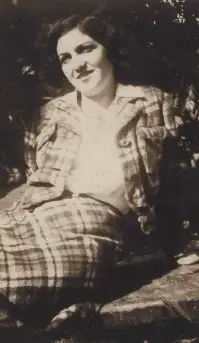
Lena who helped in recruiting labour.
German propaganda had painted Indian troops as barbarians and ruthless. This did affect the locals and they kept away till almost the end of the war. The Italians were curious to know Douglas’ religion. For an Italian one is either a Roman Catholic or a Muslim! So when he told them he was a neither they were surprised!
They did become friendly and would invite Indian soldiers to celebrate the victory. Lakshmi Kanthan managed to learn conversational Italian which helped in socialising with the friendly people of Bari.
The war had come to an end, and Lakshmi Kanthan was tasked to stay back with a small team after most of the troops had been repatriated. This was to clear mines and perhaps run a sawmill. He had to rely on local labour for certain tasks.
Life in Italy and the end of the war
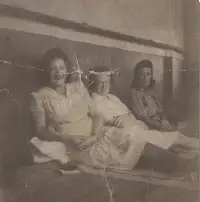
Italians of Bari who welcomed the Indians Lena who helped in recruiting labour.
Lieutenant Sukhias RIE, was the Officer Commanding who joined the company either in Egypt or Italy. A wartime commissioned officer, he was liked by the troops and was thoughtful to engage a local Italian photographer to take these group photographs.
Lakshmi Kanthan finally returned to India in October 1945. He and 12 Field Company had served overseas for four years and three months. His parents were anxious as no one before him had joined the military. On his return, in August 1946, he was commissioned as a Second Lieutenant in the Royal Indian Engineers (RIE).
He bought an HMV Gramophone player and some popular vinyl records from Italy along with many HMS booklets on ‘A Soldiers Guide to Italian.’ Two popular songs he brought home to India were ‘Oi’ Maree and ‘Ah Trombe Terrestre ‘.
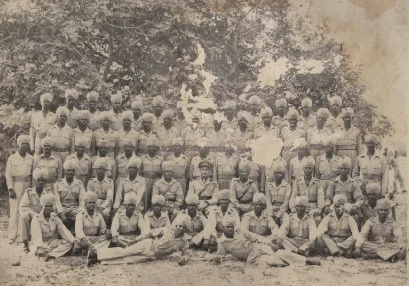
12 Field Company QVO Madras Sappers and Miners
Additional reading and references:
JOHN ANCRUM CAMERON was the commanding officer during the war years up to the Italian Campaign. This narrates the operations of 12 Field Company in the North African Campaign.
Extract from “Indian Sappers and Miners”
By Lieut.-Colonel E.W.C. Sandes D.S.O., M.C., R.E. (Ret.) This relates to the fact that 12 Filed Company was in the NWFP region and corroborates the anecdotes of my father.


